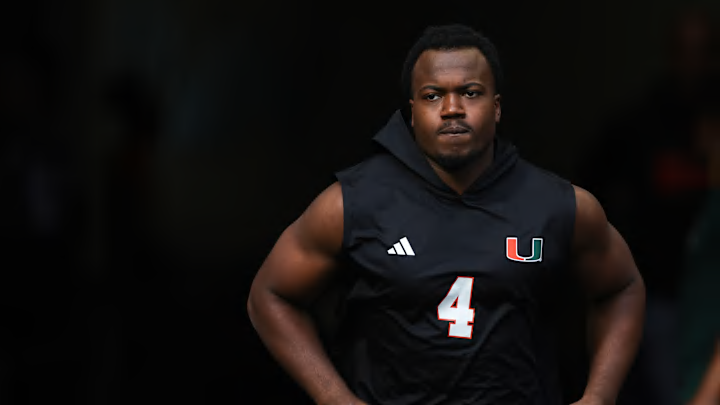For what seems like forever, the Saints have long invested in edge defenders built on power, length, and versatility, and the 2026 NFL Draft is shaping up to offer a deep menu of options across all three days.
Whether they’re searching for a blue-chip disruptor, a rugged rotational presence, or a late-round swing on traits, the upcoming class has prospects who match the organization’s long-standing thresholds and front-multiplicity on defense.
From day-one talents to toolsy developmental bets on day three, here are six edge defenders -- two on each day -- Saints fans should have circled heading into next spring.
EDGE prospects for Saints to monitor in 2026 NFL Draft
Day 1: Reuben Bain Jr., Miami
Bain Jr. headlines the 2026 edge class and enters the cycle as arguably the premier defender -- and potentially the premier player -- in the entire draft. Miami has asked him to carry an enormous workload this fall, and opponents responded by throwing double teams at him on a near-weekly basis.
But even through that traffic, his tape shows a dense, powerful, scheme-versatile edge who can line up as a 3–4 defensive end or a true 4–3 edge without sacrificing impact. He’s comfortable stacking, anchoring, and resetting the line of scrimmage on early downs, and in isolation snaps, something he’ll see more often in the NFL, he can win inside, win outside, or flatten to the quarterback with power-to-speed.
He checks every box the Saints tend to value in an edge threat: play strength, alignment flexibility, and an NFL-ready understanding of block recognition.
Day 1: David Bailey, Texas Tech
If Bain is the class’s sledgehammer, Bailey is its electricity: lean, long, twitchy, and explosive in every phase.
At 6-foot-3, 250 pounds, the Texas Tech and former Stanford standout has been one of the most dominant defenders in college football in 2025 (13 sacks in 11 games), consistently showing up as a force in all three downs.
His range allows him to work in space, chase down perimeter runs, and even drop into the flats for disguised looks, and few edge players in the class combine his fluidity and pass-rush approach.
While his frame is wiry, his ability to convert speed into late power keeps tackles guessing, and for New Orleans, he profiles as the type of movable chess piece who can be deployed as a wide rusher or walked up over tight ends to create mismatches.
Day 2: LT Overton, Alabama
Overton fits the Saints’ historical prototype as well as anyone in this entire group: big, powerful, dense, and scheme-friendly.
Still just 21 years old, he could have entered last year’s draft as one of the youngest prospects in the class, and his physical maturity continues to develop. At nearly 280 pounds, Overton brings early-down sturdiness and the positional flexibility to rep multiple spots -- three-tech, five-tech, 4i -- without looking out of place.
He’s still growing as a speed threat and likely won’t win consistently on the outside shoulder yet, but young power rushers often take longer to sharpen their finesse. What he can do already is collapse pockets, forklift tackles, and win ugly rep after ugly rep with effort and strength.
For a Saints defense that has long preferred edges who can defend the run and kick inside situationally, Overton checks the boxes.
Day 2: Zion Young, Missouri
Young has turned a fresh opportunity at Missouri (former Michigan State transfer) into one of the SEC’s better breakout seasons.
At 6-foot-5, 262 pounds, he presents more of an odd-front defensive end frame, with long arms and a sturdier upper body that allows him to stack, peek, and shed at a high level. His first step is closer to average than explosive, but his rush plan has grown, and his ability to finish plays has become a selling point.
Evaluators are already drawn to his production in the conference (33 pressures in 10 games), and the Saints -- who appreciate edge defenders who can play physical, disciplined football on early downs -- will value his reliability and length. If the hand counters keep coming, Young could climb into the top-75 conversation.
Day 3: Clev Lubin, Louisville
Lubin offers the kind of traits and power profile teams love to mine on Day 3.
At 250 pounds, Lubin punches above his weightclass, with the strength to anchor and set a hard edge rather than relying solely on finesse or speed. His late-season surge in production (10 pressures, two sacks the last two weeks) has showed a player gaining confidence in his leverage, timing, and finishing ability inside the pocket.
For New Orleans, Lubin projects as a rotational edge while developing a deeper set of counters.
Day 3: Patrick Payton, LSU
If you lined up every defender in this class and asked who looks the most like a long-term NFL starter, Payton would be near the front of the line.
At 6-foot-6, 255 pounds with rare length and natural movement skills, he once carried legitimate first-round buzz at Florida State before transferring to LSU.
The tools remain outstanding, but the consistency hasn’t arrived -- yet. But that's the question, will it ever arrive?
Payton is a classic high-upside Day 3 swing: the frame, fluidity, and reach all scream NFL edge, but he has not put together the dominant stretch of on-field play that matches his physical gifts. Should that light bulb flip on, a team like the Saints could walk away with one of the steals of the draft.
